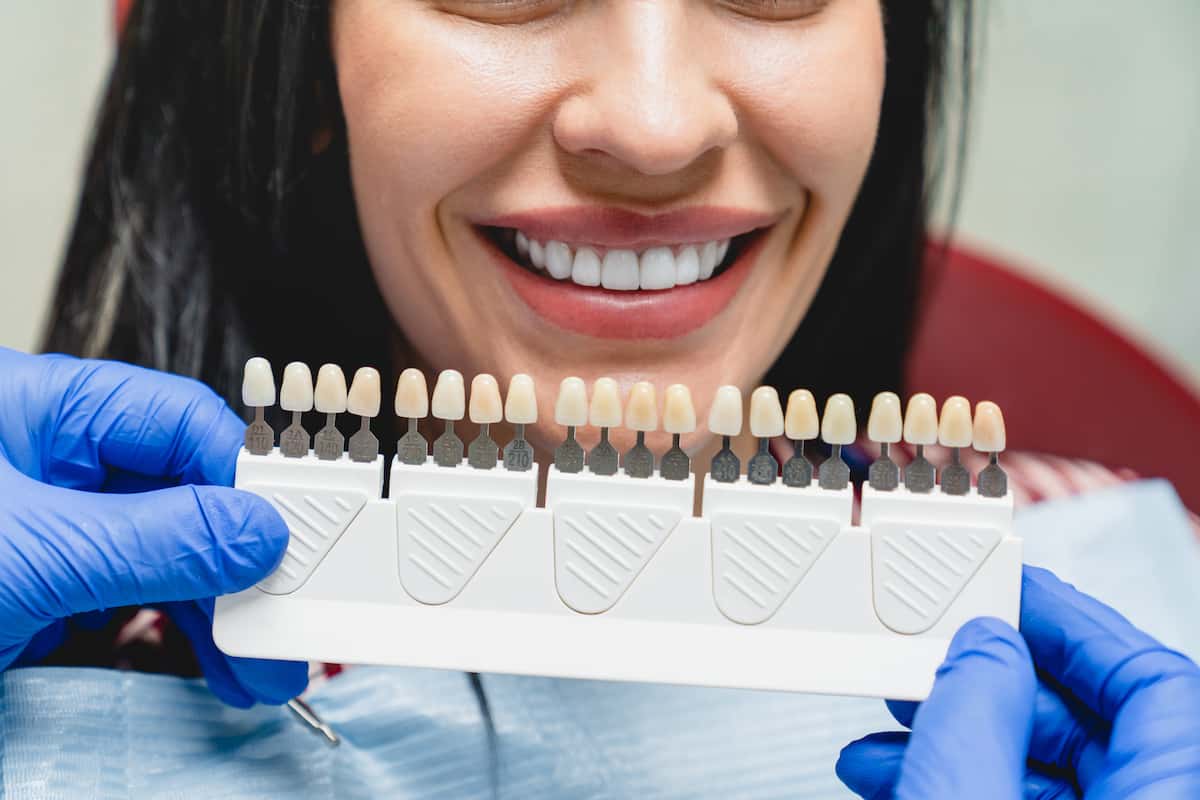We all love a bright, white, friendly smile. Whether it’s for a big event, a job interview, or just to boost your every day, it’s easy to spread the love with just a smile when your teeth make you feel happy and confident. Teeth whitening, both professional and DIY is a great way to enhance your smile and your confidence.
Teeth whitening is a popular and cost-effective cosmetic dentistry treatment. There are many ways to brighten and whiten your teeth, so many that the options can be overwhelming. This teeth whitening guide will outline the benefits, risks, and results that you can expect from the different teeth whitening products available so you can choose the right option for your teeth and your smile. The guide covers:
- How does teeth whitening work?
- What causes teeth discolouration?
- What results can I expect?
- What are the different types of teeth whitening treatments available?
- How to choose the right treatment – risks & results
- Who is NOT suitable for teeth whitening procedures
How does the teeth whitening process work?
Professional teeth whitening treatments rely on a bleaching agent, either hydrogen peroxide or carbamide peroxide to improve discolouration and remove staining. The peroxide soaks through the enamel to penetrate the slightly softer dentine, and here, the bleaching agent and oxygen react with the coloured molecules that cause discolouration. The stained dentine lightens and the natural teeth become whiter. Hydrogen peroxide and carbamide peroxide can also make the enamel surface more reflective which helps the teeth appear whiter and shinier.
Over-the-counter teeth whitening products generally can only buff the surface of the tooth, and results are therefore not as remarkable or long-lasting.
What causes teeth discolouration?
Tooth discolouration and staining are usually caused by:
- Intrinsic factors:
- Antibiotic use when teeth are forming
- Medications
- Ageing
- Disease processes
- Extrinsic factors;
- Coffee
- Tea
- Red Wine
- Curries
- Cola
- Smoking
- Chromogenic Bacteria
The best way to limit tooth discolouration is to avoid or moderate the consumption of these common foods and drinks before and after whitening treatments.
What results can I expect?
Teeth whitening results depend on the chosen treatment method and on the initial shade of the teeth. Yellowed teeth often achieve brighter results than brownish teeth. Grey teeth can be quite resistant to whitening or may require more intense treatment. The most effective and fastest results are achieved with ‘laser-enhanced’ treatments such as Zoom! Teeth whitening, which can improve your teeth by 8-10 shades in just one hour. Understanding the capabilities and limitations of all types of whitening processes will help you choose the best whitening product for your smile, your health, and your budget.
Teeth whitening treatments
- Professional teeth whitening with your dentist
Professional whitening treatments administered by your dentist will give you the fastest most effective results. You will notice the difference after your first treatment and may only need one or two sessions. Professional teeth whitening uses hydrogen peroxide or carbamide peroxide at higher concentrations than over-the-counter treatments and the bleaching effect can then be amplified with the addition of the LED light such as that used in Zoom! Teeth whitening.
Professional whitening treatments allow your dentist to ensure your natural teeth are prepared for your chosen treatment and to monitor the health of your teeth and gums throughout. This means you are less likely to suffer sensitivity and more likely to achieve a great result.
Your treatment package can also include an at-home touch-up kit which can prolong and maintain your new winning smile for up to a year.
- Dentist prescribed take-home teeth whitening systems
Dental whitening trays provide a dentist-prescribed at-home teeth whitening system. After an initial, in-office treatment you can continue your teeth whitening regime at home using a custom-made whitening tray to apply the bleaching agent to your teeth. Unlike over-the-counter tray options, custom-made trays ensure maximum contact between the whitening gel and your tooth surface. Great results can be achieved with consistent treatment once per day for 1 – 2 weeks. You will need to check back in with your dentist over the course of your treatment.
- Teeth whitening strips
Whitening strips are an easy-to-access, easy-to-use whitening option. There are various brands of strips available at a range of price points. It is important to check the active ingredients and look for strips that are Dental Association approved. If you are not sure, consult your dentist before commencing treatment. Whitening strips usually contain some form of peroxide which is delivered to the teeth for a prescribed length of time. Strips can be more effective at overall brightening than whitening toothpaste and paint-on whitening gel, but can often result in uneven colouration due to poor contact across the tooth surface. Strips can also lead to tooth sensitivity and gum irritation if used incorrectly or for prolonged periods. Whitening strips should be used with caution and only as directed.
- Whitening gel (over the counter)
Whitening gel purchased over the counter usually contains an abrasive and a bleaching agent. Gels are painted onto the tooth surfaces using a small brush. Like whitening strips, they can result in uneven colouration due to variances in the application. Whitening Gel generally uses a milder abrasive than whitening pastes and is less likely to cause sensitivity, but care should be taken to avoid making contact with soft gum tissues.
- Whitening toothpaste
Whitening toothpaste can be a great low-cost, long-term whitening solution. Unlike professional in-office or take-home dentist-prescribed whitening treatments, whitening toothpaste does not penetrate the enamel. Whitening toothpaste uses a mild abrasive, usually baking soda, silica or dicalcium phosphate, to buff away surface stains. Some pastes may also be boosted by a small amount of hydrogen peroxide or carbamide peroxide, but again this only works on the surface of the tooth. Whitening toothpaste takes much longer to achieve much less remarkable results and prolonged or vigorous brushing can damage tooth enamel resulting in tooth sensitivity.
Activated charcoal toothpaste
Touted as a safe, natural alternative, activated charcoal toothpaste does not contain any bleaching agents.
Activated charcoal is charcoal that has been heated with gas to create pores, these pores draw and trap toxins which can then be expelled. This action is what makes activated charcoal the most popular poison treatment globally. Proponents of Charcoal toothpaste claim that bacteria and stains can be drawn out of the tooth by this same mechanism however there is little evidence to support this theory. Charcoal toothpaste may cause people to brush longer in an effort to remove the black colouring, while more thorough brushing can sometimes be beneficial, it is more likely that the abrasive quality of charcoal will cause damage to tooth enamel that in the longer term may result in tooth sensitivity and tooth wear.
It is best to book a check-up with your dentist before starting any DIY whitening treatment.
How to choose the right teeth whitening products – risks & results
Increased tooth sensitivity is the most common side-effect of all teeth whitening processes. This has been noted in all treatments from cheap over-the-counter kits to more costly in-office professional treatments. Increased tooth sensitivity is usually temporary. Professional whitening treatments and dentist-prescribed at-home teeth whitening kits contain desensitising agents to limit this effect.
Before starting cosmetic dentistry treatments, you will need to consider what fits your health, lifestyle, and budget. Whichever way you choose to go, it is always recommended you book in to see your dentist for a check-up and quote before you start.
Check out Bite Dental’s New Patient offer.
Who is not suitable for teeth whitening?
Teeth whitening procedures are generally very safe for everyone but it is not recommended for children until all their adult teeth have erupted and matured, this is usually about 2 years after their last adult tooth arrives.
Tooth whitening procedures will not work on dental restorations such as veneers or fillings. Uneven colouration can make restoration work more noticeable so it is always advisable to consult with your dentist before going ahead with any sort of teeth whitening treatment.
Can I whiten my teeth while I am pregnant?
Unfortunately, the short answer is – no. While there is no evidence to suggest that teeth whitening is unsafe during pregnancy, there is also no evidence to ensure it is safe. So, it is best to hold off on all whitening treatments until after your baby is born and you have finished breastfeeding.
Growing a human affects almost every part of the mother’s body. Hormone alterations can result in gum inflammation and bleeding and heightened tooth sensitivity, even a whitening toothpaste or whitening gel may be unbearable during this time.
Cosmetic dentistry treatments such as teeth whitening don’t need to be overwhelming, they can be rewarding and fun. No matter how you get there, a brighter, whiter smile always leaves you feeling happy and confident. Talk to the Bite Dental team about your options today.


